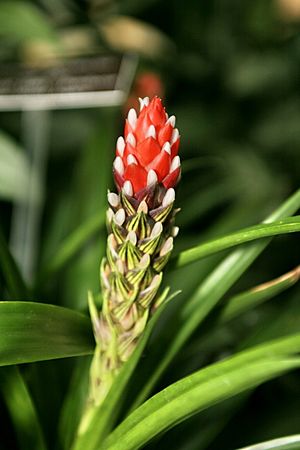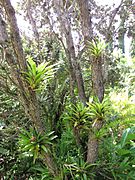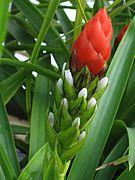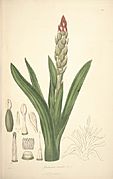Guzmania monostachia facts for kids
Guzmania monostachia is a cool plant that grows on other plants! It's a type of species in the Guzmania family. People also call it the West Indian tufted airplant.
This plant is originally from places like South America (Bolivia, Brazil, Colombia, Ecuador, Peru, Venezuela), Central America, the West Indies, and Florida. You can also find it growing wild in Hawaii.
Guzmania monostachia is special because it has a clever way to save water. It can switch how it makes its food (a process called photosynthesis) depending on how much sunlight it gets or if it's very dry. This helps it survive in tough conditions.
Quick facts for kids Guzmania monostachia |
|
|---|---|
 |
|
| Scientific classification | |
| Genus: |
Guzmania
|
| Species: |
monostachia
|
| Synonyms | |
|
|
What is an Epiphyte?
Guzmania monostachia is an epiphyte. This means it's a plant that grows on another plant, like a tree branch. But don't worry, it's not a parasite!
Epiphytes don't take food or water from the plant they grow on. They get all their nutrients from the air, rain, and decaying leaves around them. It's like they're just using the other plant as a place to sit and get sunlight.
How it Stays Hydrated
This plant has a special trick to deal with hot, dry weather. It uses something called CAM photosynthesis.
Most plants open tiny holes in their leaves during the day to take in carbon dioxide. But this also makes them lose water. CAM plants are different.
They open their holes at night when it's cooler and less sunny. This helps them save a lot of water. Then, during the day, they use the stored carbon dioxide to make their food. It's a very smart way to survive in places where water can be scarce.
Gallery
-
A drawing of the Guzmania monostachia from the "Collectanea botanica or Figures and botanic Illustrations of rare and curious exotic Plants" by John Lindley.
See also
 In Spanish: Guzmania monostachia para niños
In Spanish: Guzmania monostachia para niños




